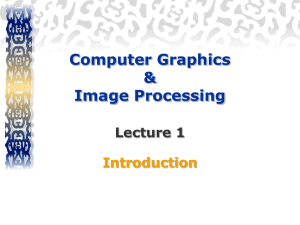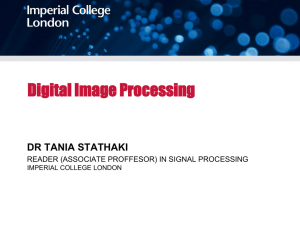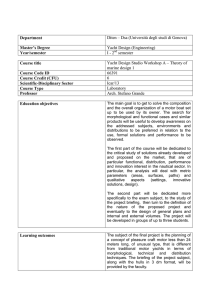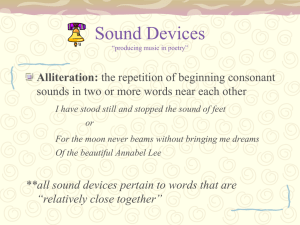Morphological Image Processing
advertisement
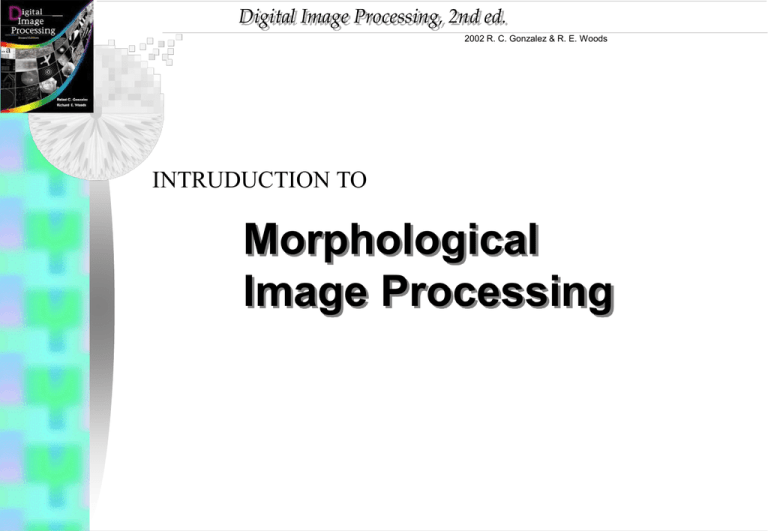
Digital Image Processing, 2nd ed.
2002 R. C. Gonzalez & R. E. Woods
INTRUDUCTION TO
Morphological
Image Processing
Digital Image Processing, 2nd ed.
2002 R. C. Gonzalez & R. E. Woods
Morphological Image Processing
Introduction
The word morphology commonly denotes a
branch of biology that deals with the form and
structure of animals and plants.
Therefore, morphological operations are intended
to affect the shape of the object
Digital Image Processing, 2nd ed.
2002 R. C. Gonzalez & R. E. Woods
Morphological Image Processing
We use mathematical morphology as a tool for
extracting image components that are useful in
the representation and description of region shape,
such as
boundaries extraction
skeletons
convex hull
morphological filtering
thinning
pruning
Digital Image Processing, 2nd ed.
2002 R. C. Gonzalez & R. E. Woods
Morphological Image Processing
Sets in mathematic morphology represent
objects in an image:
binary image (0 = black, 1 = white) :
the element of the set is the coordinates (x,y) of
pixel belong to the object Z2
gray-scaled image :
the element of the set is the coordinates (x,y) of
pixel belong to the object and the gray levels
Z3
Digital Image Processing, 2nd ed.
2002 R. C. Gonzalez & R. E. Woods
Morphological Image Processing
A is a set in Z2 ,
a=(a1,a2) an element of A, aA If not, then aA
: null (empty) set
A subset of B: AB
Union of A and B: C=AB
Intersection of A and B: D=AB
Disjoint sets: AB=
Complement of A: Ac = {x|xA}
Difference of A and B:
A-B = {x|x∈A, x B} = A∩Bc
Digital Image Processing, 2nd ed.
2002 R. C. Gonzalez & R. E. Woods
Morphological Image Processing
Operators by examples:
Digital Image Processing, 2nd ed.
2002 R. C. Gonzalez & R. E. Woods
Morphological Image Processing
Reflection and Translation by examples:
Need for a reference point.
Reflection of B:
= {x|x=-b, for b∈B}
Translation of A by x=(x1,x2), denoted by (A)x is defined as:
(A)x = {c| c=a+x, for a∈A}
Bˆ
Reference point
Digital Image Processing, 2nd ed.
2002 R. C. Gonzalez & R. E. Woods
Morphological Image Processing
Basic Logic Operations:
Digital Image Processing, 2nd ed.
2002 R. C. Gonzalez & R. E. Woods
Morphological Image Processing
Digital Image Processing, 2nd ed.
2002 R. C. Gonzalez & R. E. Woods
Morphological Image Processing
Two Fundamental Morphological Operators:
Dilation:
1.
2.
Obtaining the reflection of B about its origin and then shifting
this reflection by x
The dilation of A by B then is the set of all x displacements
such that and A overlap by at least one nonzero element…
(B is the structuring element in dilation)
Relation to Convolution mask:
- Flipping
- Overlapping
Dilation is typically applied to binary image, but there are
versions that work on gray scale image.
Digital Image Processing, 2nd ed.
2002 R. C. Gonzalez & R. E. Woods
Morphological Image Processing
Suppose that X is the set of coordinates
corresponding to the input binary image, and that
K is the set of coordinates for the structuring
element.
Let Kx denote the translation of K so that its origin
is at x.
Then the dilation of X by K is simply the set of all
points x such that the intersection of Kx with X is
non-empty.
Digital Image Processing, 2nd ed.
2002 R. C. Gonzalez & R. E. Woods
Morphological Image Processing
Suppose that the structuring element is a 3×3 square .
Note that in subsequent diagrams, foreground pixels are represented by
1's and background pixels by 0's.
To compute the dilation of a binary input image by this structuring
element, we superimpose the structuring element on top of the input
image so that the origin of the structuring element coincides with the
input pixel position.
If the center pixel in the structuring element coincides with a foreground
pixel in the image underneath, then the input pixel is set to the
foreground value.
1
1
1
1
1
1
1
1
1
Structuring element
Digital Image Processing, 2nd ed.
2002 R. C. Gonzalez & R. E. Woods
Morphological Image Processing
MATLAB CODE:
clear all;
B=zeros(256,256); % create 256x256 image
for i=128:160
for j=128:160 B(i,j)=1;
end
end
for i=20:25
for j=30:190 B(i,j)=1;
end
end
i=1;
while i<40 % generate 40 random pixels
x=uint8(rand*255); y=uint8(rand*255);
B(x,y)=1;i=i+1;
end
imshow(B); title('Original image');
K3=ones(3); K5=ones(5); K7=ones(7); K9=ones(9); % create kernels
B3=imdilate(B,K3); B5=imdilate(B,K5); % apply dilation
B7=imdilate(B,K7); B9=imdilate(B,K9);
figure; imshow(B3); title('Dilated image with 3 by 3');
figure; imshow(B5); title('Dilated image with 5 by 5');
figure; imshow(B7); title('Dilated image with 7 by 7');
figure, imshow(B9); title('Dilated image with 9 by 9');
Digital Image Processing, 2nd ed.
2002 R. C. Gonzalez & R. E. Woods
Morphological Image Processing
Dilation by example:
Digital Image Processing, 2nd ed.
2002 R. C. Gonzalez & R. E. Woods
Morphological Image Processing
Dilation is typically applied to binary image, but there
are versions that work on gray scale image.
The basic effect of the operator on a binary image is to
gradually enlarge the boundaries of regions of
foreground pixels (i.e. white pixels, typically).
Thus areas of foreground pixels grow in size while
holes within those regions become smaller.
Digital Image Processing, 2nd ed.
2002 R. C. Gonzalez & R. E. Woods
Morphological Image Processing
The basic effect of the operator on a binary image is to
gradually enlarge the boundaries of regions of foreground
pixels (i.e. white pixels, typically).
Digital Image Processing, 2nd ed.
2002 R. C. Gonzalez & R. E. Woods
Morphological Image Processing
Summary effects of dilation:
Expand/enlarge objects in the image
Fill gaps or bays of insufficient width
Fill small holes of sufficiently small size
Connects objects separated by a distance less than
the size of the window
Digital Image Processing, 2nd ed.
2002 R. C. Gonzalez & R. E. Woods
Morphological Image Processing
Erosion:
i.e. the erosion of A by B is the set of all points x
such that B, translated by x, is contained in A.
It is typically applied to binary image, but there are versions that
work on gray scale image.
The basic effect of the operator on a binary image is to erode
away the boundaries of regions of foreground pixels (i.e. white
pixels, typically).
Thus areas of foreground pixels shrink in size, and holes within
those areas become larger.
Digital Image Processing, 2nd ed.
2002 R. C. Gonzalez & R. E. Woods
Morphological Image Processing
Digital Image Processing, 2nd ed.
2002 R. C. Gonzalez & R. E. Woods
Morphological Image Processing
Suppose that the structuring element is a 3×3 square .
Note that in subsequent diagrams, foreground pixels are
represented by 1's and background pixels by 0's.
The structuring element is now superimposed over each
foreground pixel ( input pixel ) in the image. If all the
pixels below the structuring element are foreground
pixels then the input pixel retains it’s value. But if any of
the pixels is a background pixel then the input pixel gets
the background pixel value.
1
1
1
1
1
1
1
1
1
Structuring element
Digital Image Processing, 2nd ed.
2002 R. C. Gonzalez & R. E. Woods
Morphological Image Processing
Another example:
MATLAB CODE
% read image
I=imread('cameraman.tif');
% convert to binary image
B=im2bw(I,0.3);
% create kernels
K3=ones(3);
K5=ones(5);
K7=ones(7);
K9=ones(9);
% apply erosion
B3=imerode(B,K3);
B5=imerode(B,K5);
B7=imerode(B,K7);
B9=imerode(B,K9);
% display images
imshow(B);title('original image');
figure, imshow(B3);title('eroded image with 3 by 3');
figure, imshow(B5);title('eroded image with 5 by 5');
figure, imshow(B7);title('eroded image with 7 by 7');
figure, imshow(B9);title('eroded image with 9 by 9');
Digital Image Processing, 2nd ed.
2002 R. C. Gonzalez & R. E. Woods
Morphological Image Processing
Dilation-Erosion Duality:
Digital Image Processing, 2nd ed.
2002 R. C. Gonzalez & R. E. Woods
Morphological Image Processing
Digital Image Processing, 2nd ed.
2002 R. C. Gonzalez & R. E. Woods
Morphological Image Processing
Opening and Closing:
Dilation expands and Erosion shrinks.
Opening:
An erosion followed by a dilation using the same structuring
element for both operations.
Smooth contour
Break narrow isthmuses
Remove thin protrusion
Digital Image Processing, 2nd ed.
2002 R. C. Gonzalez & R. E. Woods
Morphological Image Processing
Closing:
A Dilation followed by a erosion using the same
structuring element for both operations.
Smooth contour
Fuse narrow breaks, and long thin gulfs.
Remove small holes, and fill gaps.
Digital Image Processing, 2nd ed.
2002 R. C. Gonzalez & R. E. Woods
Morphological Image Processing
Digital Image Processing, 2nd ed.
2002 R. C. Gonzalez & R. E. Woods
Morphological Image Processing
Digital Image Processing, 2nd ed.
2002 R. C. Gonzalez & R. E. Woods
Morphological Image Processing
Digital Image Processing, 2nd ed.
2002 R. C. Gonzalez & R. E. Woods
Morphological Image Processing
Hit-or-Miss Transform
The hit-or-miss transform is a general binary morphological
operation that can be used to look for particular patterns
of foreground and background pixels in an image.
The hit-and-miss transform is a basic tool for shape
detection.
Concept: To detect a shape:
Hit object
Miss background
Digital Image Processing, 2nd ed.
2002 R. C. Gonzalez & R. E. Woods
Morphological Image Processing
Hit-or-Miss Transform
The structural elements used for Hit-or-miss transforms are an
extension to the ones used with dilation, erosion etc.
The structural elements can contain both foreground and
background pixels, rather than just foreground pixels, i.e. both
ones and zeros.
The structuring element is superimposed over each pixel in the
input image, and if an exact match is found between the
foreground and background pixels in the structuring element and
the image, the input pixel lying below the origin of the structuring
element is set to the foreground pixel value. If it does not match,
the input pixel is replaced by the boundary pixel value.
Digital Image Processing, 2nd ed.
2002 R. C. Gonzalez & R. E. Woods
Morphological Image Processing
The hit-or-miss transform is defined as:
Let B ={B1, B2}, where B1 is the set formed from
elements of B associated with an object and B2 is
the set of elements of B associated with the
corresponding background, where B1 and B2 are
disjoint.
Digital Image Processing, 2nd ed.
2002 R. C. Gonzalez & R. E. Woods
Morphological Image Processing
Hit-and-Miss Transform
B1: Object related
B2: Background related
Digital Image Processing, 2nd ed.
2002 R. C. Gonzalez & R. E. Woods
Morphological Image Processing
Applications
Boundary Extraction
The boundary of a set X is obtained by first eroding
X by structuring element K and then taking the set
difference of X and it’s erosion.
The resultant image after subtracting the eroded
image from the original image has the boundary of
the objects extracted. The thickness of the boundary
depends on the size of the structuring element.
Digital Image Processing, 2nd ed.
2002 R. C. Gonzalez & R. E. Woods
Morphological Image Processing
Boundary Extraction
Digital Image Processing, 2nd ed.
2002 R. C. Gonzalez & R. E. Woods
Morphological Image Processing
Digital Image Processing, 2nd ed.
2002 R. C. Gonzalez & R. E. Woods
Morphological Image Processing
Applications
Region Filling:
Start form p inside boundary.
Digital Image Processing, 2nd ed.
2002 R. C. Gonzalez & R. E. Woods
Morphological Image Processing
Semi-automated to cancel reflection effect
Digital Image Processing, 2nd ed.
2002 R. C. Gonzalez & R. E. Woods
Morphological Image Processing
Applications
Connected components Extraction:
Start from p belong to desired region.
Digital Image Processing, 2nd ed.
2002 R. C. Gonzalez & R. E. Woods
Morphological Image Processing
Digital Image Processing, 2nd ed.
2002 R. C. Gonzalez & R. E. Woods
Morphological Image Processing
Applications
Thinning:
Digital Image Processing, 2nd ed.
2002 R. C. Gonzalez & R. E. Woods
Morphological Image Processing
Convert to m-connection
Digital Image Processing, 2nd ed.
2002 R. C. Gonzalez & R. E. Woods
Morphological Image Processing
Applications
Thickening
Digital Image Processing, 2nd ed.
2002 R. C. Gonzalez & R. E. Woods
Morphological Image Processing
Applications
Skeletons A with notation S(A):
For z belong to S(A) and (D)z, the largest disk
centered at z and contained in A, one can not find a
larger disk containing (D)z and included in A.
Disk (D)z touches the boundary of A at two or
more different points.
Digital Image Processing, 2nd ed.
2002 R. C. Gonzalez & R. E. Woods
Morphological Image Processing
Digital Image Processing, 2nd ed.
2002 R. C. Gonzalez & R. E. Woods
Morphological Image Processing
Skeletons A with notation S(A):
Digital Image Processing, 2nd ed.
2002 R. C. Gonzalez & R. E. Woods
Morphological Image Processing
The final
skeleton not
only thicker it
needs to be ,but
more important
is not
connected.
Digital Image Processing, 2nd ed.
2002 R. C. Gonzalez & R. E. Woods
Morphological Image Processing
Applications
Pruning
Removing parasitic component complement to thinning
and skeletonizing by successive elimination its end
point.
Digital Image Processing, 2nd ed.
2002 R. C. Gonzalez & R. E. Woods
Morphological Image Processing
Digital Image Processing, 2nd ed.
2002 R. C. Gonzalez & R. E. Woods
Morphological Image Processing
Digital Image Processing, 2nd ed.
2002 R. C. Gonzalez & R. E. Woods
Morphological Image Processing
Digital Image Processing, 2nd ed.
2002 R. C. Gonzalez & R. E. Woods
Morphological Image Processing
Digital Image Processing, 2nd ed.
2002 R. C. Gonzalez & R. E. Woods
Morphological Image Processing
Extension to Gray-Level images:
f(x,y): the input image
b(x,y): a structuring element (a subimage function)
(x,y) are integers.
f and b are functions that assign a gray-level value
(real number or real integer) to each distinct pair of
coordinate (x,y)
Digital Image Processing, 2nd ed.
2002 R. C. Gonzalez & R. E. Woods
Morphological Image Processing
Extension to Gray-Level images:
Dilation:
Df and Db are the domains of f and b, respectively.
condition (s-x) and (t-y) have to be in the domain of f
and (x,y) have to be in the domain of b is similar to the
condition in binary morphological dilation where the
two sets have to overlap by at least one element
Digital Image Processing, 2nd ed.
2002 R. C. Gonzalez & R. E. Woods
Morphological Image Processing
Dilation Similarity with Convolution:
f(s-x) : f(-x) is simply f(x) mirrored with respect to the original of
the x axis. the function f(s-x) moves to the right for positive s, and
to the left for negative s.
Max operation replaces the sums of convolution
Addition operation replaces with the products of convolution.
• General effect
If all the values of the structuring element are positive, the output
image tends to be brighter than the input
Dark details either are reduced or eliminated, depending on how
their values and shapes relate to the structuring element used for
dilation.
Digital Image Processing, 2nd ed.
2002 R. C. Gonzalez & R. E. Woods
Morphological Image Processing
Digital Image Processing, 2nd ed.
2002 R. C. Gonzalez & R. E. Woods
Morphological Image Processing
Erosion:
Condition (s+x) and (t+y) have to be in the domain
of f and (x,y) have to be in the domain of b is
similar to the condition in binary morphological
erosion where the structuring element has to be
completely contained by the set being eroded.
Digital Image Processing, 2nd ed.
2002 R. C. Gonzalez & R. E. Woods
Morphological Image Processing
Similarity to 2D correlation
f(s+x) moves to the left for positive s and to the right for
negatives.
• General effect
If all the elements of the structuring element are positive, the
output image tends to be darker than the input
The effect of bright details in the input image that are smaller in
area than the structuring element is reduced, with the degree of
reduction being determined by the gray-level values surrounding
the bright detail and by the shape and amplitude values of the
structuring element itself.
Digital Image Processing, 2nd ed.
2002 R. C. Gonzalez & R. E. Woods
Morphological Image Processing
Digital Image Processing, 2nd ed.
2002 R. C. Gonzalez & R. E. Woods
Morphological Image Processing
Erosion-Dilation Duality:
Digital Image Processing, 2nd ed.
2002 R. C. Gonzalez & R. E. Woods
Morphological Image Processing
Digital Image Processing, 2nd ed.
2002 R. C. Gonzalez & R. E. Woods
Morphological Image Processing
Opening-Closing:
Same (binary) relation with Dilation-Erosion:
Digital Image Processing, 2nd ed.
2002 R. C. Gonzalez & R. E. Woods
Morphological Image Processing
Digital Image Processing, 2nd ed.
2002 R. C. Gonzalez & R. E. Woods
Morphological Image Processing
Opening-Closing Properties:
Opening:
Closing:
e↵r indicates that the domain of e is a subset of the domain of r, and also
that e(x,y) ≤ r(x,y) for any (x,y) in the domain of e
Digital Image Processing, 2nd ed.
2002 R. C. Gonzalez & R. E. Woods
Morphological Image Processing
Opening
The structuring element is rolled underside the surface of f
All the peaks that are narrow with respect to the diameter of the
structuring element will be reduced in amplitude and sharpness
So, opening is used to remove small light details, while leaving
the overall gray levels and larger bright features relatively
undisturbed.
The initial erosion removes the details, but it also darkens the
image.
The subsequent dilation again increases the overall intensity of
the image without reintroducing the details totally removed by
erosion.
Digital Image Processing, 2nd ed.
2002 R. C. Gonzalez & R. E. Woods
Morphological Image Processing
Closing
The structuring element is rolled on top of the surface of f
Peaks essentially are left in their original form (assume that their
separation at the narrowest points exceeds the diameter of the
structuring element)
So, closing is used to remove small dark details, while leaving
bright features relatively undisturbed.
The initial dilation removes the dark details and brightens the
image
The subsequent erosion darkens the image without reintroducing
the details totally removed by dilation
Digital Image Processing, 2nd ed.
2002 R. C. Gonzalez & R. E. Woods
Morphological Image Processing
Opening: Decreased size
of small bright details. No
changes to dark region
Closing: Decreased size
of small dark details. No
changes to bright region
Digital Image Processing, 2nd ed.
2002 R. C. Gonzalez & R. E. Woods
Morphological Image Processing
Smoothing
Digital Image Processing, 2nd ed.
2002 R. C. Gonzalez & R. E. Woods
Morphological Image Processing
Gradient
Digital Image Processing, 2nd ed.
2002 R. C. Gonzalez & R. E. Woods
Morphological Image Processing
Top-hat:
Enhancing details in presence of shades
Digital Image Processing, 2nd ed.
2002 R. C. Gonzalez & R. E. Woods
Morphological Image Processing
Textural segmentation
1. Performing closing with successive larger structuring
element till removing the small blobs
2. Performing Simple opening
3. Performing Simple thresholding
Digital Image Processing, 2nd ed.
2002 R. C. Gonzalez & R. E. Woods
Morphological Image Processing
Granulometry:
Used to determine size distribution
1. Performing opening operations with structuring elements of
increasing size.
2. Computing the difference between original image and its
opening .
3. Normalizing values and constructing particles size distributions
Digital Image Processing, 2nd ed.
2002 R. C. Gonzalez & R. E. Woods
Morphological Image Processing
Reference
Digital Image Processing, 2nd ed.
2002 R. C. Gonzalez & R. E. Woods
Hands-on Morphology Image Processing
By Handson
Digital Image Processing, 2nd ed.
2002 R. C. Gonzalez & R. E. Woods
Morphological Image Processing
Thank you
for your attention


